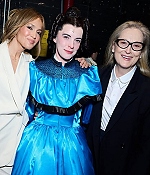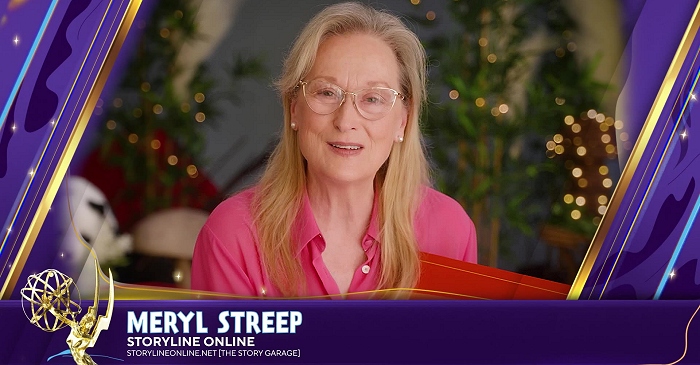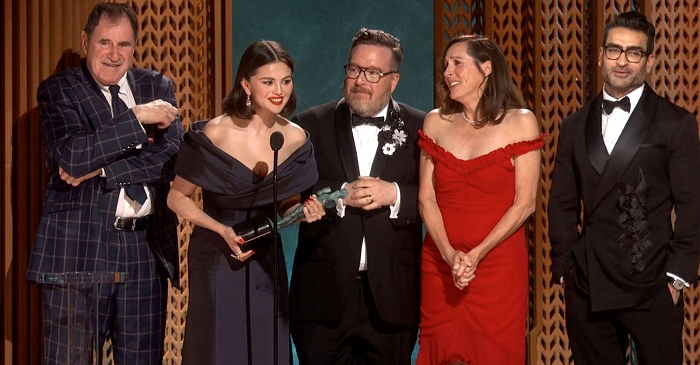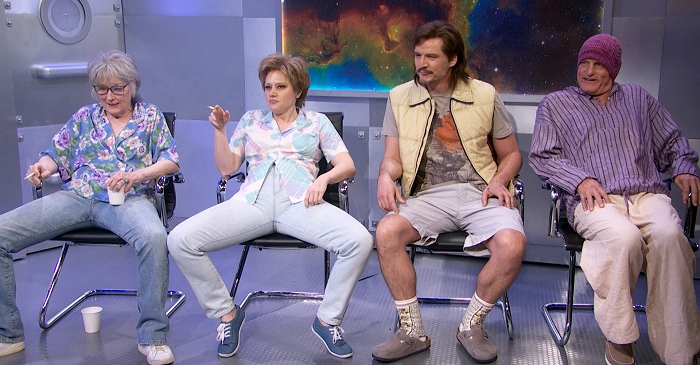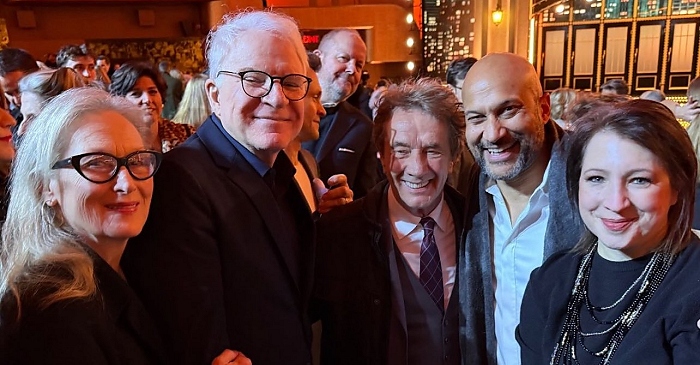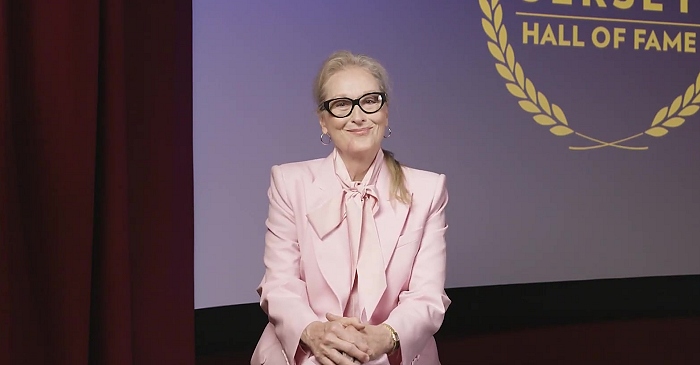|
Simply Streep is your premiere source on Meryl Streep's work on film, television and in the theatre - a career that has won her the praise to be one of the world's greatest working actresses. Created in 1999, we have built an extensive collection to discover Miss Streep's body of work through articles, photos and videos. Enjoy your stay.
|
Celebrating
25 years
of SimplyStreep
|
|
Sympathy for the She-Devil? Not in this movie
The Orange County Register ·
December 08, 1989
· Written by Jim Emerson
|
Susan Seidelman’s 1985 “Desperately Seeking Susan” was a kitschy, kooky, effervescent little comic confection. But since then – with the flatfooted “Making Mr. Right” and, especially, this year’s stale “Cookie” – the fizz has gone out of her work. Seidelman’s new “She-Devil” kicks off with a candy-colored beauty-parlor montage sequence that self-consciously hearkens back to the similar opening of “Desperately Seeking Susan.” Howard Shore’s witty, campy score begins with a delectably cheesy chorus of breathy female voices cooing, Sergio Mendes & Brasil ’66-style: “Oooo,” “Aaaah” and “Ba-ba-dahbaaaaaah” – recalling Betty Everett’s hipper “The Shoop Shoop Song (It’s in His Kiss)” from “Susan.” The strategy is clear from the outset: It was Seidelman who gave Madonna her bigscreen debut (and her only credible movie role) as Susan, the leather-clad bohemian who seemed to have achieved a Zen-like state of consciousness that perpetually (and exquisitely) balanced boredom with casual disdain. When Madonna/Susan munched Cheetos on the poolside chaise longue, the pop idol and the pop fiction fused into one iconographic image. Before “Desperately Seeking Susan,” people wondered if Madonna could “act.” But her performance (like Roseanne Barr’s on her TV show) made the question almost irrelevant. Let’s just say that, in this case, she and her character co-existed (or coincided) propitiously. And so, it makes for perfect Hollywood logic that Barr – another nasal-voiced non-actress with a sarcastic, deadpan popular persona – should move into film comedy under Seidelman’s direction.
At first glance, the part of vengeful suburban housewife and eponymous heroine Ruth Patchett would seem to be tailormade for Barr, just as Susan proved ideally suited to Madonna’s thespian strengths and (more importantly) limitations. Barr’s popular ABC sitcom was developed from her autobiographical stand-up comedy routine, and “She-Devil” itself (although it’s actually based on Fay Weldon’s novel, “The Life and Loves of a She-Devil”) might well have been spun from one of Barr’s own revenge-fantasy monologues. Ruth’s domestic dreams are shattered when her accountant husband. Bob (Ed Begley Jr.), abandons her for an affair (both business and personal) with Mary Fisher (Meryl Streep), the rich and famous author of florid pulp romance novels for women. Mary goes from being Ruth’s idol to the movie’s villainess in a single fateful evening. In the middle of a marital quarrel just before he leaves Ruth and their kids for Mary, Bob angrily lists his assets: home, family, career, freedom. Ruth retaliates by sabotaging the items on this list, checking them off one by one, and methodically destroying the lives of her husband and Mary in the process.
At the beginning of the film, Ruth, with an enormous brown mole above her lip, is grossly unattractive – and intentionally so. Mary, the “Reiping Royal Highness of Romance,” as Robin Leach might describe her, would appear to have everything (fame, money and a pale, WASP-ish beauty); Ruth has nothing but her home and family. Later, Mary says she knows Bob married Ruth only out of “kindness and pity.” Initially, at least, we’re supposed to pity and sympathize with Ruth, too. That’s what ought to make her revenge so sweet. But Barr does not invite pity or sympathy. Part of her appeal is that she’s perfectly comfortable with who she is and makes no apologies – for her weight or her crassness or anything else. When, at the start of the picture she calls Bob from the mall beauty parlor to tell him how much she’s looking forward to going to a dinner party that night, she’s meant to appear vulnerable and sincere – characteristics that are entirely outside of Barr’s range. Barr reads Ruth’s early lines mockingly and dismissively, as if she were reading them, unrehearsed, off cue cards. She tips her hand too soon, letting us know that she can’t wait to shrug off this housewifey persona and transform herself into the monstrous, avenging She-Devil of the title. Consequently, her revenge seems more cruel than cathartic.
If, just once, we thought that Barr’s Ruth was genuinely hurt by her husband’s betrayal, the movie might have worked as an outlet for the Wrath of Ruths everywhere. Seidelman attempts to convey Ruth’s emotional state with a comic Gothic/expressionist style (dizzying crane shots, tilted angles, extreme close-ups) – but when, for example, the camera swoops down on Ruth, standing on the front lawn and screaming in rage and agony, Barr just stands there with her mouth open and you sense that the scream was dubbed in later. It doesn’t sound like it comes from the gut, anyway. Likewise, Ruth’s/Barr’s voiceover narration seems emotionally disconnected, out of sync with the images on screen. Streep’s performance as Mary, on the other hand, has all the relish of an actress taking her own revenge on critics who’ve criticized her for being too mannered and mechanical an actress – all technique and no spontaneity. (She even flips off critics during an appearance on Sally Jesse Raphael’s television show near the end of the movie.)
In earlier movies such as “The French Lieutenant’s Woman,” “Falling in Love” and even her Oscar-winning “Sophie’s Choice,” Streep’s overdeliberate behavioral tics were sometimes unintentionally absurd. As Henry Fonda put it, describing what he believed to be an actor’s worst sin, you could always “see the wheels turning.” Well, in “She-Devil” – her first (and long-awaited) comedy – Miss Mannerisms shifts into overdrive. Streep’s Mary acts out her highly visible public role – at parties and in interviews – with the same careful calculation with which she composes one of her elaborately overwritten sentences. (Upon first meeting Bob, she pronounces him gallant – as in “gah- LAHNT.”)
Every pause, gesture and squeaky coquettish breath that punctuates Mary’s conversation is precisely chosen and placed for judicious effect, as if it were a comma, an adjective or an exclamation point in one of her novels. Mary is a very bad actress, which makes Streep’s outlandish, mercurial shifts from one stilted pose, one overaccented emotion, to another, so hysterically funny. Unlike Barr, Streep totally commits to her character, shamelessly strutting her stuff so that sometimes you laugh just because that’s Meryl Streep up there, going through all those parodic contortions . . . and reveling in it. “You wanna see mannered?” Streep seems to be saying. “I’ll give you mannered!” “She-Devil” ends with an image of feminist triumph and apotheosis, the streets filling with women all striding purposefully toward their own self-determined destinies. Sadly, this muddled, misconceived comedy doesn’t live up to it.

